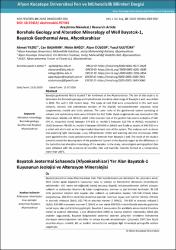Borehole geology and alteration mineralogy of well bayatcık-1, bayatcık geothermal area, Afyonkarahisar
Citation
Yıldız, A. , Başaran, C. , Bağcı, M. , Dülger, A. & Ulutürk, Y. (2020). Borehole Geology and Alteration Mineralogy of Well Bayatcık-1, Bayatcık Geothermal Area, Afyonkarahisar . Afyon Kocatepe Üniversitesi Fen Ve Mühendislik Bilimleri Dergisi , 20 (4) , 683-692 . DOI: 10.35414/akufemubid.707341Abstract
Bayatçık geothermal field is located 7 km northwest of the Afyonkarahisar. The aim of this study is to determine the borehole geology and hydrothermal alteration mineralogy of Bayatçik-1 well, was drilled in 2013. The well is 925 meters deep. The types of rock that were encountered in this well were alluvium, volcanic and sedimentary sections of the Köprülü volcanosedimanter sequence, basal conglomerate, marble and schist sections. The cover rocks of the geothermal system consisting of volcanic and sedimentary rocks were drilled in the first 528m. Basal conglomerate was observed in 528- 558 m level. Marble unit (Mrb1), which is the reservoir rock of the geothermal system at depths of 558- 574 m, micaschist (Sch1) between 574-622 m, marble-2 between 622-746 m (Mrb2), micaschist-2 (Sch2) between 746-830 m, marble-3 between 830-890 m (Mrb3) and finally at depths of 890-920 m is a schist unit which acts as the impermeable basement rock of the system. The analyzes such as stereo and polarizing light microscope, x-ray diffractometer (XRD) and scanning electron microscope (SEM) were applied to the clastic samples taken at 2m intervals from Bayatçik-1 well. The result of the study is aimed to reveal the development of the geothermal system in the Bayatcık region by the differences in the hydrothermal alteration mineralogy of the samples. In the study, mineralogical-petrographical data were obtained with the presence of smectite, illite and kaolinite minerals formed at a temperature lower than 200oC. Bayatçık jeotermal sahası Afyonkarahisar ilinin 7 km kuzeybatısında yer almaktadır. Bu çalışmanın amacı 2013 yılında açılan Bayatçik-1 kuyusunun kuyu içi jeolojisi ve hidrotermal alterasyon mineralojisini belirlemektir. 925 metre derinliğindeki sondaj boyunca; Köprülü volkanosedimanter istifinin alüvyon, volkanik ve sedimanter kısımları ile taban konglomerası, mermer ve şist birimleri kesilmiştir. İlk 528 m'de jeotermal sistemin örtü kayaları olan volkanik ve sedimanter kayalar, 528-558 m’lerde taban konglomerası, 558-574 m derinlikte Jeotermal sistemin rezervuar kayası olan mermer (Mrb1), 574-622 m arasında mikasşist (Sch1), 622-746 m arasında mermer-2 (Mrb2), 746-830 m arasında mikaşist-2 (Sch2), 830-890 m arasında mermer-3 (Mrb3) ve son olarak 890-920 m derinliklerde sistemin geçirimsiz temel kayası olan şist birimleri geçilmiştir. Bayatcık-1 kuyusundan 2m aralıklarla alınan klastik örneklere stereo ve polarize mikroskop, x-ışını difraktometre (XRD) ve tarama elektron mikroskobu (SEM) gibi analizler uygulanarak, Bayatcık bölgesindeki jeotermal sistemin gelişimini örneklerin hidrotermal alterasyon mineralojisindeki farklılıklar ile ortaya koymak amaçlanmıştır. Çalışmada 200oC’den düşük sıcaklıkta oluşan simektit, illit ve kaolinit minerallerinin varlığıyla ilgili mineralojik-petrografik verilere ulaşılmıştır.
Source
Afyon Kocatepe Üniversitesi Fen Ve Mühendislik Bilimleri DergisiVolume
20Issue
4URI
https://dergipark.org.tr/tr/download/article-file/1016617https://doi.org/10.35414/akufemubid.707341
https://hdl.handle.net/11630/9639



















